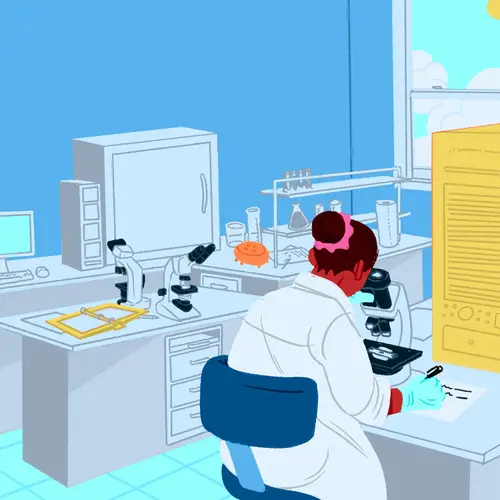Feb. 20, 2024 – When Billy Frolick, 63, collapsed in the Charlotte Douglas International Airport in North Carolina, fate was on his side. It just so happened that Lauren Westafer, DO, an emergency room doctor, was catching a connecting flight at a nearby gate.
It was Friday the 13th, May 2022. Westafer, who works at the Baystate Medical Center in Springfield, MA, was coming out of the restroom when she heard a sound like someone was snoring nearby and saw a flight attendant scurrying away from her gate. She followed the noise and came across a man on the ground with agonal breathing – when someone is gasping for air, usually as a result of cardiac arrest or stroke. In a frenzy, some bystanders checked for a pulse while the flight attendant ran back with an oxygen mask.
Westafer knew that she needed to start CPR, and fast. She turned to the flight attendant and asked for the nearest AED -- an automated external defibrillator made for situations just like these.
The flight attendant said that the airport didn’t have one.
“I was pretty rude and I said, ‘This is an airport. There is an AED. I don’t know where the nearest one is. Ask somebody, check the walls, run down the aisles until you find one,’” Westafer said.
All airports in the U.S. -- and other public places where large groups tend to gather -- are required by law to have AEDs. They are often red and kept in a white metal box attached to a wall. Westafer said the flight attendant returned very quickly with an AED in hand.
Automated external defibrillators are different from the defibrillators used in hospitals; Westafer calls them “essentially foolproof.” There are clear instructions that show you step-by-step where to put the pads and what to do next.
During a cardiac arrest, there are four different types of EKG (electrocardiographic) rhythms that can occur. Only two of those are shockable, and part of the AED’s job is to determine whether the patient should be shocked.
The stars aligned yet again for Frolick when the AED read “shock advised.” This is what you want to see in this situation, said Westafer. “Then you have the best chance of getting somebody back.”
Chest compressions were also an extremely crucial part of Frolick’s resuscitation. Seven of his ribs broke in the process – which isn’t unusual during CPR – one which cut his liver. Frolick had technically died for those 10 minutes, but every 30 to 45 seconds during CPR, he’d start to move his hands or flex his knees.
Ultimately, however, getting your hands on an AED is often a matter of life and death.
“The goal I had was getting a shock as quickly as possible because the longer your heart is in this funky rhythm and you can’t shock, it’s going to devolve into a rhythm you can’t shock. Then your options are extremely limited,” Westafer said. “That’s why access is so important.”
When medics arrived and hooked him up to a heart monitor, she was able to see that Frolick’s heart was now in a normal rhythm. After they loaded him onto a stretcher, he was even able to tell the EMTs and Westafer his name.
As an emergency medicine doctor, it’s not often that Westafer gets to see patients come back to life. Research has shown that the survival rate of out-of-hospital cardiac arrests is only about 10%, taking the lives of about 350,000 people a year in the U.S.
Before the ordeal, Frolick said he had been hospitalized three times for chest tightness. His doctors put a stent in, gave him a prescription for nitroglycerin, and sent him on his way.
“I was popping nitroglycerin like they were Tic Tacs” Frolick said. “In the Charlotte airport between flights, I felt the tightness, took the nitro, and it was the last thing I remember until staring up at three doctors from a hospital bed.”
Cardiologist Paul Chan, MD, has been studying trends in AED usage and out-of-hospital cardiac arrest survival rates for years.
“In states that have laws requiring AEDs in gyms specifically, we see higher rates of bystanders even just applying the AED to individuals in cardiac arrest,” said Chan. “But we’d like to see that percentage be higher. Ideally, we’d expect that, in those states, there would be mandatory training for staff to know where the nearest AED is.”
Both Chan and Westafer said that when someone collapses due to cardiac arrest, some bystanders might freeze up. Chaos might ensue. But as long as one person gets an AED to the patient, there’s a higher chance that someone will be able to step in and administer the shock, if advised.
“He was lucky he died in an airport,” Westafer said of Frolick, because all 50 states require AEDs in airports. Even if staff isn’t properly trained to know where they’re located or when they need to be used, like in Frolick’s case, someone will likely be able to find one pretty quickly.
After a week in the hospital, Frolick – indeed one of the luckiest unlucky guys out there – had recovered from his cardiac arrest. And nearly 2 years later, he and Westafer remain friends.
Still, usage of AEDs in public settings remains low (2%-5%), according to a CDC study, mostly because of a lack of knowledge, bystanders’ reticence to put them to use, and limited access to AEDs in general.
You don’t need to be an ER doctor to save a life, you just have to know what to look for.
